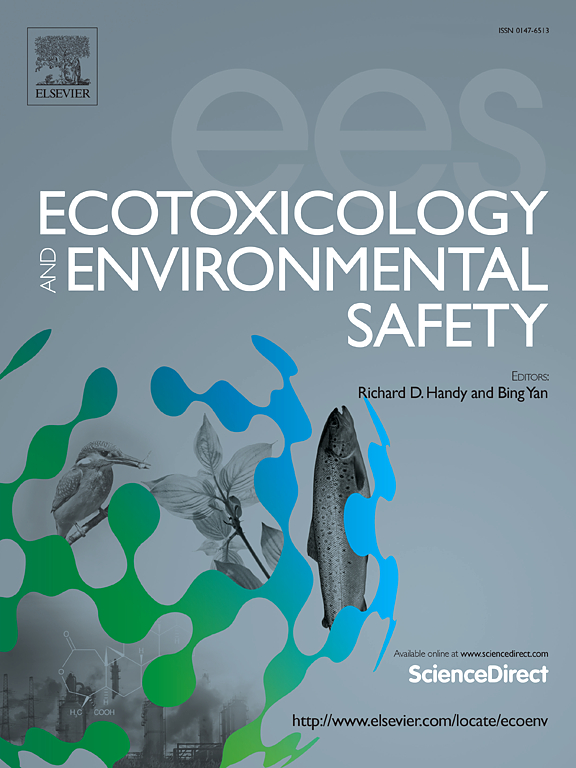Distributions of pathogenic bacteria, antibiotic resistance genes, and virulence factors in pig farms in China
IF 6.1
2区 环境科学与生态学
Q1 ENVIRONMENTAL SCIENCES
引用次数: 0
Abstract
The abundance of antibiotic resistance genes (ARGs) in pig feces can lead to their dissemination in the pig farm environment, posing a serious risk to human health through potential exposure and transmission. However, the extent of microbial contamination in pig farms, including ARGs, virulence factor genes (VFGs), mobile genetic elements (MGEs), and human bacterial pathogens (HBPs), is still largely unknown. In this study, metagenomics was employed to identify the composition and characteristics of microorganism communities, ARGs, VFGs, MGEs and HBPs in pig farm environments from seven different regions of China. The results showed that there were significant differences in the composition of microorganisms and Firmicutes, Bacteroides, Proteobacteriahe Spirochaetes were the dominant phyla in the pig farm environment. The abundance and composition of ARGs, VFGs, MGEs and HBPs varied significantly in pig farm environments in different regions, with the abundance in Fujian being significantly higher than that in other regions. In total, 216 ARGs, 479 VFGs, 143 MGEs and 78 HBPs were identified across all pig feces, soil, and wastewater samples. The most prominent ARGs were those related to tetracycline, aminoglycoside, and MLS resistance. Escherichia coli, Arcobacter cryaerophilus, Corynebacterium xerosis, Aerococcus viridans, and Collinsella aerofaciens were the most commonly found HBPs in the pig farm environment. Procrustes analysis and Mantel test results showed a strong correlation between ARGs and HBPs, VFGs and HBPs, and ARGs and VFGs. ARGs were mainly harbored by E. coli, Klebsiella pneumoniae, and Enterococcus faecalis in the pig farm environments. The random forest model indicated that the presence of MGEs (intI1, IS91, and tnpA) was significantly correlated with the total abundance of resistance genes, which can be utilized as an important indicator for measuring resistance genes. The study establishes a foundational understanding of the prevalence and diversity of ARGs, VFGs, and HBPs in pig farm environments, aiding in the development of effective management strategies to mitigate ecological and public health risks.
中国养猪场病原菌、抗生素耐药基因及毒力因子分布
猪粪中丰富的抗生素耐药基因(ARGs)可导致其在猪场环境中传播,通过潜在的接触和传播对人类健康构成严重风险。然而,猪场中微生物污染的程度,包括ARGs、毒力因子基因(vfg)、移动遗传因子(MGEs)和人类细菌病原体(HBPs),在很大程度上仍然未知。本研究采用宏基因组学方法,对中国7个不同地区猪场环境中微生物群落、ARGs、vfg、MGEs和HBPs的组成和特征进行了研究。结果表明:猪场环境中微生物组成差异显著,厚壁菌门、拟杆菌门、变形菌门和螺旋体菌门为优势门;不同地区猪场环境中ARGs、vfg、MGEs和HBPs的丰度和组成差异显著,其中福建的丰度显著高于其他地区。在所有猪粪便、土壤和废水样本中共鉴定出216种ARGs、479种vfg、143种MGEs和78种HBPs。最突出的ARGs与四环素、氨基糖苷和MLS耐药有关。猪场环境中最常见的HBPs为大肠杆菌、嗜冷杆菌、干燥棒状杆菌、绿气球菌和气法大肠杆菌。Procrustes分析和Mantel试验结果显示,ARGs与HBPs、vfg与HBPs、ARGs与vfg之间存在较强的相关性。猪场环境中ARGs主要由大肠杆菌、肺炎克雷伯菌和粪肠球菌携带。随机森林模型显示,MGEs (intI1、IS91和tnpA)的存在与抗性基因总丰度显著相关,可作为测定抗性基因的重要指标。该研究建立了对猪场环境中ARGs、vfg和HBPs的患病率和多样性的基本认识,有助于制定有效的管理策略,以减轻生态和公共卫生风险。
本文章由计算机程序翻译,如有差异,请以英文原文为准。
求助全文
约1分钟内获得全文
求助全文
来源期刊
CiteScore
12.10
自引率
5.90%
发文量
1234
审稿时长
88 days
期刊介绍:
Ecotoxicology and Environmental Safety is a multi-disciplinary journal that focuses on understanding the exposure and effects of environmental contamination on organisms including human health. The scope of the journal covers three main themes. The topics within these themes, indicated below, include (but are not limited to) the following: Ecotoxicology、Environmental Chemistry、Environmental Safety etc.

 求助内容:
求助内容: 应助结果提醒方式:
应助结果提醒方式:


